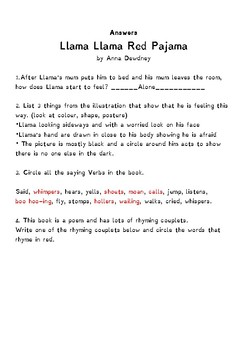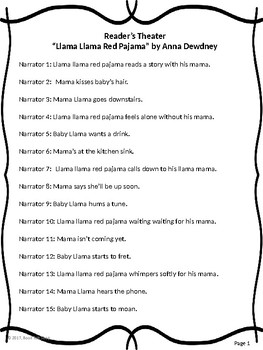Unpacking The Heartfelt Lyrics Of 'Llama Llama Red Pajama': More Than Just A Children's Song
In the vast landscape of children's literature and entertainment, few characters have captured hearts quite like Llama Llama. Clad in his distinctive red pajamas, this endearing character, brought to life by the late, great author and illustrator Anna Dewdney, has become synonymous with comforting bedtime routines and relatable childhood emotions. While the books themselves are cherished for their rhyming narratives and vibrant illustrations, the musical adaptations, particularly the lyrics of "Llama Llama Red Pajama," have taken on a life of their own, echoing through nurseries and living rooms worldwide. But what makes these seemingly simple lines so profoundly impactful? Let's dive into the lyrical journey of Llama Llama and discover the layers of meaning woven into his red pajama story.
The Enduring Appeal of Llama Llama
Before dissecting the lyrics, it's crucial to understand the foundation of Llama Llama's widespread appeal. Anna Dewdney’s series masterfully tackles universal childhood experiences: bedtime jitters, separation anxiety, the comfort of routine, and the boundless love between a child and their parent. Llama Llama isn't just a cute animal; he's a mirror reflecting the emotional complexities of young children. His worries and joys are palpable, making him incredibly relatable for kids, while his Mama Llama's patient and reassuring presence offers comfort to both child and parent. This relatability is precisely what makes the transition from book to song so seamless and effective, allowing the core messages to resonate even more deeply through melody and rhythm.
Deconstructing the Core Lyrics: A Bedtime Ritual
The essence of the "Llama Llama Red Pajama" narrative is beautifully encapsulated in its most common lyrical adaptations. These lines often serve as the backbone for various musical renditions, painting a vivid picture of a familiar bedtime scene.
The Opening Scene: Comfort and Connection
The song typically opens with a scene of warmth and security, setting a comforting tone that parents and children alike can instantly connect with. The lyrics provided in "Llama Mama Lyrics" perfectly capture this initial tranquility:
Llama, llama (uh)
Red pajama
Reads a story with who?
With his mama! (hey!)
This stanza establishes the central relationship and the cherished bedtime ritual. It highlights the importance of shared moments, the comfort derived from a parent's presence, and the soothing routine of a story before sleep. It's a snapshot of idyllic childhood, a moment of pure connection and security that every child yearns for and every parent strives to provide. The simple rhymes and repetitive structure are perfect for young listeners, making the lyrics easy to remember and sing along to.
Mama's Departure: The Seed of Anxiety
However, the narrative soon shifts, introducing the first hint of the central conflict that drives the Llama Llama story. As the "Llama Mama Lyrics" continue:
Mama kisses (what)
Baby hair
Mama llama goes all the way downstairs (ayy!).
This seemingly innocuous act – Mama Llama going downstairs – is the catalyst for Llama Llama's anxiety. It’s a moment that many children experience daily: the parent leaving the room, even if just for a moment. This brief separation, though necessary, can feel monumental to a young child. As noted in the Camila Cabello rendition, the lyrics often hint at Llama Llama being "alone without his" Mama, emphasizing the sudden feeling of solitude that can creep in after the initial comfort fades. This transition from shared warmth to perceived loneliness is what makes the story, and its lyrical adaptations, so powerful and relatable to children dealing with separation anxiety at bedtime.
The Llama's Dilemma (Implied in Lyrics)
While the provided lyrical snippets primarily cover the initial setup, they implicitly lead to the core dilemma of the book: Llama Llama's growing worry and eventual wail when Mama doesn't immediately return. The simplicity of the "Llama llama red pajama" phrase, repeated throughout, acts as a refrain that anchors the narrative. Each repetition, depending on the context of the song, can convey a different emotional state – from contentment to growing unease. The genius of these lyrics lies in their ability to convey a complex emotional arc with minimal words, allowing children to project their own feelings onto Llama Llama's experience and find reassurance in the eventual resolution.
From Page to Stage (and Screen): Musical Adaptations
The inherent musicality of Anna Dewdney's rhyming text made "Llama Llama Red Pajama" a natural fit for musical adaptation. The book's rhythm and repetition are almost song-like, making it easy for composers and artists to transform the beloved story into catchy tunes that further engage young audiences.
Popular Renditions and Their Reach
The "Llama Llama Red Pajama" song has been embraced by various artists and platforms, extending its reach far beyond the printed page. From dedicated "Llama Llama Red Pajama Sing-a-Long!" videos designed for interactive viewing to professional recordings, the song has found many homes. Interestingly, the data highlights its presence in diverse musical contexts:
- Karaoke Apps: The mention of "Llama Llama Red Pajama by Kali Uchis - Karaoke Lyrics on Smule" indicates its popularity on social singing platforms. This shows how even mainstream artists' interpretations can make their way into public karaoke, allowing fans to engage directly with the lyrics.
- Mainstream Artists: The fact that artists like "Camila Cabello" and "That Mexican OT" have covered or referenced "Llama Llama Red Pajama" speaks volumes about its cultural penetration. While their versions might offer unique twists or interpretations, they all stem from the same beloved source material, introducing the story to new audiences through their musical styles. That Mexican OT's version, for example, offers a slightly different phrasing ("I go read the story with Mama Mama kisses baby hair's, Mama Mama 'boutta go-...") demonstrating how the core narrative can be adapted while retaining its essence.
- Online Resources: Websites like Lyrics.com compile "a list of lyrics, artists and songs that contain the term 'llama+llama+red+pajama+song'," showcasing the sheer volume and variety of musical adaptations available, making it easy for anyone to find and sing along.
These adaptations not only make the story more accessible but also add a new dimension to the experience, allowing children to actively participate through singing and movement.
Why Musical Versions Resonate
The musical versions of "Llama Llama Red Pajama" resonate deeply for several reasons:
- Enhanced Engagement: Music adds an auditory layer that can captivate children more effectively than reading alone. The rhythm and melody make the story more memorable and enjoyable.
- Language Development: Singing along helps children develop vocabulary, phonological awareness, and rhythm. The repetitive nature of the lyrics reinforces new words and sentence structures.
- Emotional Processing: The song's gentle ebb and flow, mirroring Llama Llama's emotional journey, can help children process their own feelings about bedtime and separation in a safe, comforting way.
- Interactive Experience: Sing-alongs encourage participation, turning a passive listening experience into an active, engaging one. This fosters a love for reading and music simultaneously.
The Universal Message Within Simple Rhymes
Beyond the catchy tunes and adorable character, the lyrics of "Llama Llama Red Pajama" carry a profound universal message. They address the fundamental human need for security and reassurance, especially during vulnerable moments like bedtime. The story, whether read or sung, teaches children that it's okay to feel anxious when a loved one leaves, but also that love always returns. Mama Llama’s eventual return and comforting presence reinforce the idea that parents are always there, even when out of sight. This simple narrative instills trust and resilience, making it a powerful tool for parents navigating bedtime routines and helping children overcome minor anxieties. The enduring popularity of these lyrics is a testament to their ability to speak to core human experiences with warmth, empathy, and a gentle touch.
Conclusion
"Llama Llama Red Pajama" is more than just a children's book or a catchy song; it's a cultural phenomenon that has touched millions of families. The simple yet profound lyrics, originating from Anna Dewdney's brilliant storytelling, have transcended the pages to become beloved musical pieces. Whether sung as a quiet lullaby, performed in a vibrant sing-along, or even covered by mainstream artists, the core message of comfort, reassurance, and the unbreakable bond between parent and child remains timeless. It continues to be a go-to resource for parents, a comforting presence for children, and a reminder of the magic found in everyday bedtime rituals.
Final Summary
This article explored the enduring appeal and lyrical depth of "Llama Llama Red Pajama." We delved into the core lyrics, highlighting how they depict a universal bedtime ritual, from the initial comfort with Mama Llama to the subtle introduction of separation anxiety. We also examined the widespread musical adaptations, featuring artists like Kali Uchis, Camila Cabello, and That Mexican OT, and discussed why these renditions resonate deeply with audiences, enhancing engagement and aiding child development. Ultimately, the article emphasized the powerful, universal message of parental love and reassurance conveyed through these simple, beloved rhymes, solidifying "Llama Llama Red Pajama" as a timeless classic for families everywhere.

Llama Llama Red Pajama by Anna Dewdney Worksheets by Jo Copland | TPT

Reader's Theater for Llama Llama Red Pajama by Anna Dewdney by Book

Llama Llama Red Pajama Rhyme Match Game by All Smiles in Second and